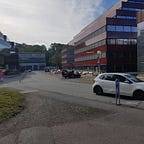ENVIRONMENT
Seminar and workshop
Seminar noise
Noise is a commonly forgotten factor of environment, but it is always present in modern day cities. On top of being annoying, noise can also become a threat to health, in fact, it is the second environmental factor in terms of health problems, only beaten by air pollution. Among others, excesive exposure to noise can produce mental problems, alteration of sleep, or even cardiovascular problems.
As Patrik Höstmad explained in the seminar, another reason to discuss the problem of noise is the trend it is following. While society’s awareness about air pollution has lead to a general decrease on emissions, noise pollution has kept steady, or even grown in some cases. Cars, the main cause of this type of pollution, hasn’t evolved quite as much in this aspect as in controlling emissions, at the same time that the policies carried out by cities have remained pretty stable as well. All and all, there has been little evolution in reducing noise pollution.
Traditional ways to reduce noise include traffic limitations (types of car in each street and speed limits) and road design (making roads that invite to drive slowly, or building houses away from the noisy roads). These methods tend to be obstructing, which can often lead to a unexpected negative reactions. However, current trends that address this issue adopt a more interesting angle. Among those, studies of low height barriers to reflect noise away from the streets and other “green barriers”, including green facades (facades covered in vegetation that ‘absorbs’ the noise) that support a more organically reduction of noise with seamless integration.
Green facades follow the current trend in city design of greening the cities started by green roofing. This new approach seems promising in solving many problems of current cities while remaining non-invasive and also contributing to a better environment. These noise reduction ideas would be, without a doubt, a thing to consider if our project was to address environment.
Other promising methods rely on the advance of technology, but not for that reason are less interesting. In addition to the obvious electrifying public transport, autonomous cars could be monitored remotely to adapt routes, speed and even acceleration in real time given the current status (in terms of noise) of the city. The final ways to reduce noise include changing the pavement (asphalt) to quieter materials, or improving the tyres to make them less noisy. All these approaches are promising in their own way, but we are probably still far away from achieving them. They would probably become less helpful in a current project, but should be closely monitored to be ready when the window opens.
In conclusion, the seminar offered us a good overview of the state of the problem, in addition to a handful of reasons why we should focus on reducing noise in cities. Patrik Höstmad did a great job creating interest and informing about the topic while keeping things short, easy to follow and interesting.
Seminar stormwater
When it comes to stormwater and rain, the city of Gothenburg have high ambitions. They have formulated a goal of being the world’s best city when it rains until 2021. This means that Chalmers campus can also become the world’s best campus when it rains! In order to achieve this, there are some challenges that needs to be handled. These includes to reduce flooding risks, improve stormwater quality, disconnect the campus area from the pipe network as well as design integrated solutions for stormwater, traffic, buildings and public spaces. Meaning, technical solutions tare needed to achieve a campus that can handle high water flows but at the same time create a nice, inviting environment for students, staff and visitors of the campus.
In general, Gothenburg has to take into account stormwater challenges due to its location and the general development of our climate. In order to manage this, the municipality have some non-binding guidelines on how to reduce stormwater in the system. These guidelines include a framework on how the stormwater should be handled through private and public land.
General solutions to manage and use water in a city include rain gardens, underground storage, green roofs and multifunctional areas. Some of these solutions can already be found at the campus area, for example green roofs and rain gardens. However, more solutions can be implemented and general knowledge about where these solution are located and how they work can increase.
Workshop
The workshop included three tasks: to describe what a good campus environment is, and which kind of storm water solutions and noise reduction solutions can be used at campus to develop and improve the campus environment.
To begin with, we made a bullet point list of a good campus environment:
- Natural light and green environment
- A campus feeling
- An environment where you feel safe and relaxed
- More social and green spaces for students to get some air and rest
- No noise disturbances
After a quick identification of what we think characterize a good campus environment is, we looked a little closer into how storm water solutions and noise alleviation can improve the campus environment. Following is a table of what we presented on the workshop.
We also gathered some inspirational pictures:
